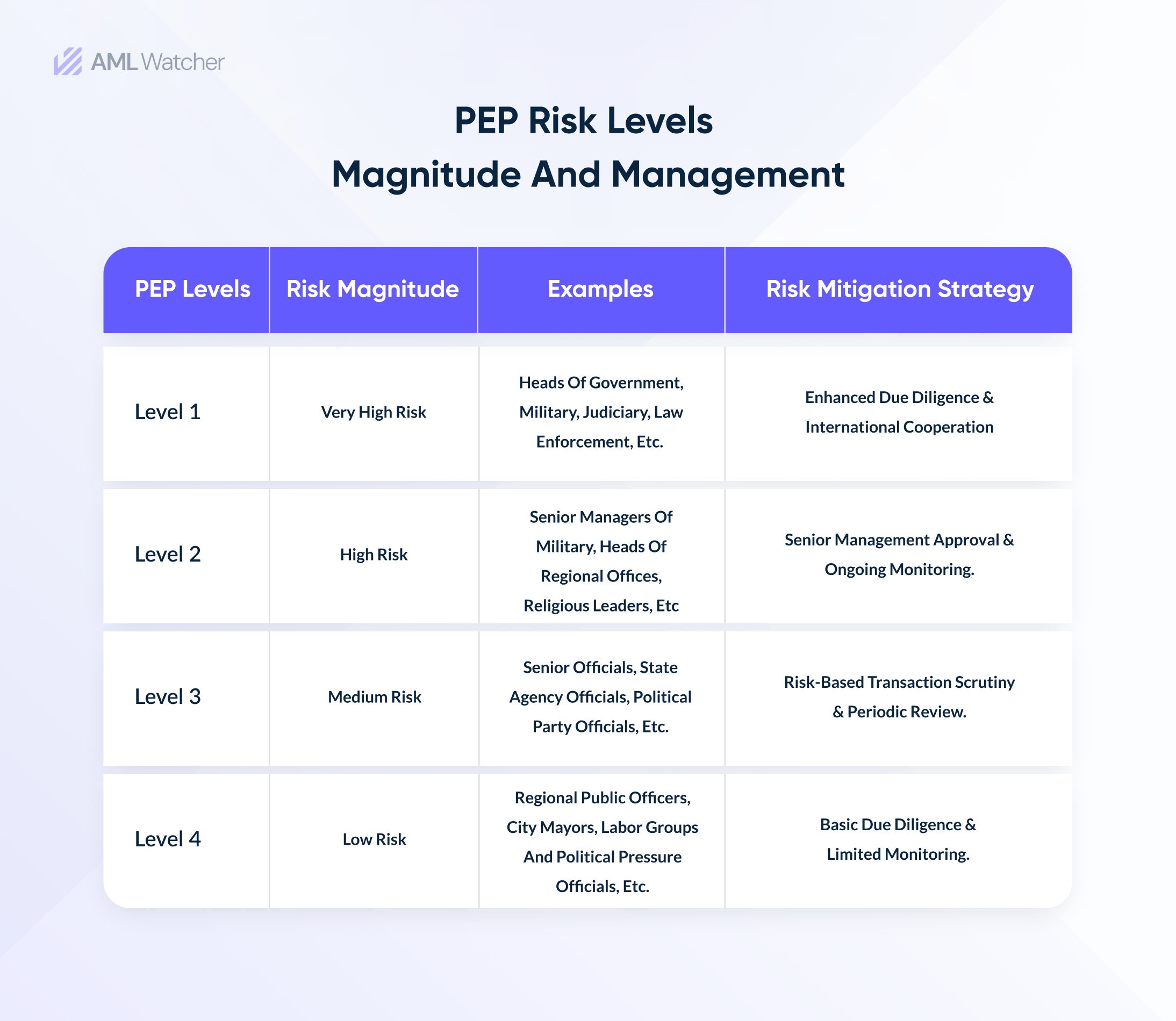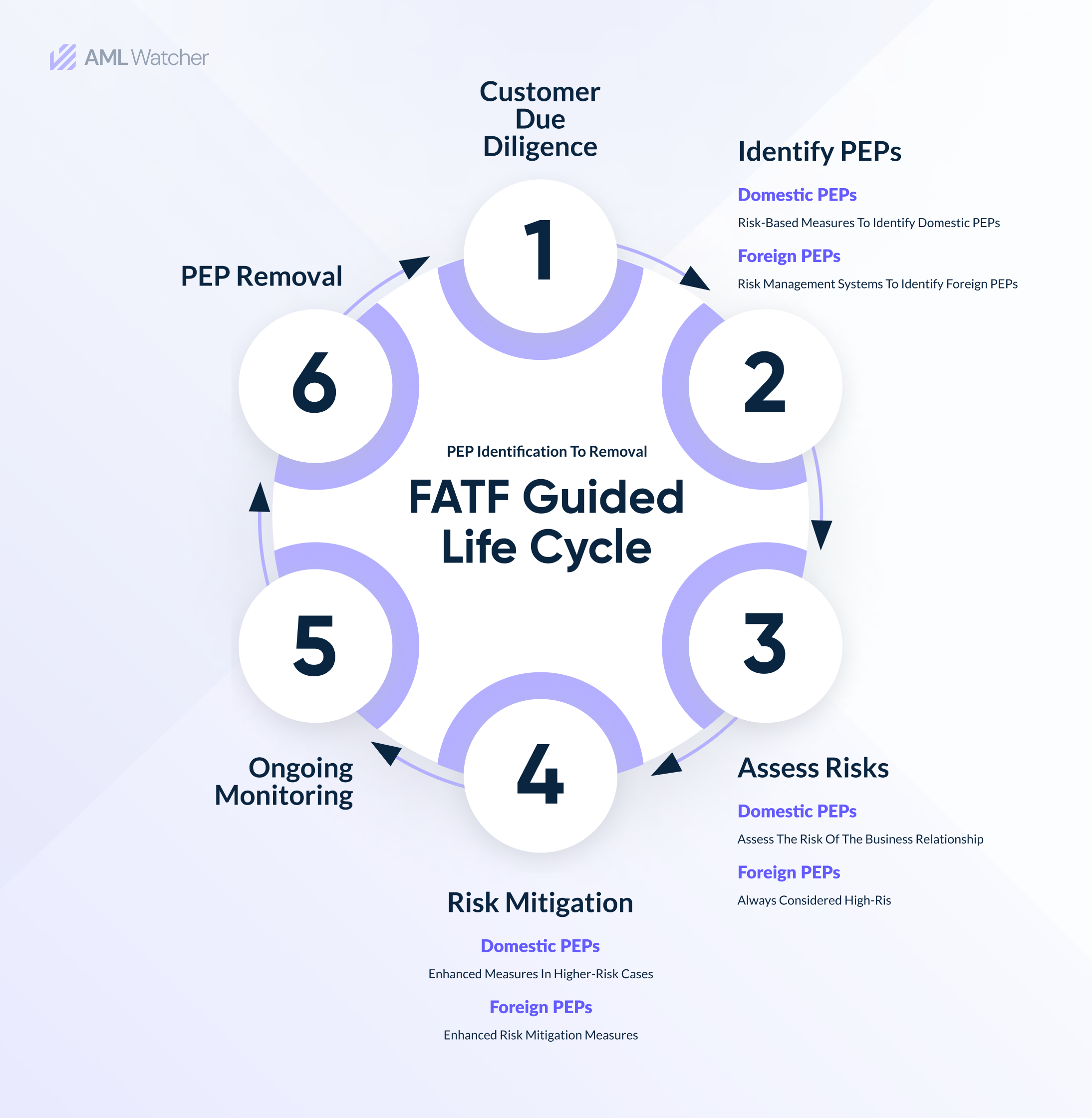
PEP Lifecycle: PEP Identification to Removal
“The global dilemma of reducing the strength of justice systems sets in by alleviating accountability for public officials, thus allowing corruption to thrive”.
Transparency International quoted the above facts while highlighting the persistently escalating corruption and power abuse by those who hold public offices and control over the justice system. The global effort to curb corruption and its associated crimes, facilitated by those who influence the governing bodies, requires every institution to conduct PEP identification and handle PEP risks with elevated compliance measures.
PEPs and their identification to align with existing AML measures play a pivotal role in the PEP screening process and meeting regulatory requirements. Due to the absence of specific guidelines other than maintaining robust due diligence, financial institutions face a gap between legislative expectations and compliance measures.
With this gap and fear of non-compliance in the form of hefty fines, financial institutions particularly, banks tend to close accounts of foreign PEPs. The inability to effectively manage PEP risks motivated Coutss Bank, one of the UK bank’s subsidiaries, to inappropriately handle Nigel Farage’s bank account. The miscalculation of PEP risks associated with the former politician and founder of Brexit caused the bank a notable fall in its market shares and the resignation of Alison Rose, former chief executive of NatWest.
Whether an innocent or a corrupt PEP, it is crucial to identify and follow global regulatory guidelines before and during business relationships with PEPs as a part of extensive AML compliance programs.
This blog will allow us to deeply analyze different dimensions of PEPs, their identification and business cycle, and declassification while leaving an open thread for institutions to decide their future compliance.
Why PEP Identification Is Crucial?
In 2003, the term PEP (politically exposed person) was introduced by the UNCAC (United Nations Convention Against Corruption). The vulnerability of public figures and government officials to launder their illicit proceeds of corruption or tax evasion is higher. Therefore, anti-money laundering (AML) measures with enhanced due diligence for PEPs and maintaining PEP data are important to meet evolving AML requirements.
According to the Stolen Assets Recovery report, globally $1 trillion to $1.6 trillion of black money is laundered every year which is a result of corruption, tax evasion, and other criminal acts. The public officials exploit their positions and possess around $20 million to $40 billion of bribe proceeds, estimated to be 20 to 40% of ODA (official development assistance).
To prevent the laundering of illicit proceeds by PEPs in developing and transitioning countries, developed countries have set forth AML guidelines and made PEP identification a non-negligible measure to curb global corruption and financial instability.
Before the intervention of FATF (Financial Action Task Force), a global regulatory body, with globally recognized Recommendations to enforce AML/CFT measures, the financial vulnerabilities of PEPs were not followed by standard procedures and bust need-based approach.
In 2003, FATF not only gave a general definition to the term PEP quoting “an individual who is or has been entrusted with a prominent function”, but recommended financial institutions and DNFBPs (designated non-financial businesses and professions) adopt enhanced due diligence while dealing with PEPs.
Note: Learn more about complex networks of PEPs and their navigation to meet compliance needs.
7 Key Matrics to Identify PEPs
Any criminal can be a PEP but not every PEP is a criminal. FATF Recommendations 12 & 22 provide enough ground to develop matrices to identify a PEP.
Role & Position
The designation of an individual both past and current in public offices including the judiciary, state-owned ventures, military, and government. These roles can be identified in terms of senior executives of government corporations, political party heads or senior members, and senior military officers.
Public Profile
An individual with an active online presence and public recognition through media coverage will also be considered a PEP.
Regional Risk
An individual who holds a public office in a region with more vulnerability to corruption or money laundering.
Family Ties
Friends of friends and family of friends who might be in close connection with a PEP. Similarly, close associates and business partners and their relationships can open doors to financial vulnerabilities.
Origin of Funds
One’s source of wealth, which is monitored during transactions, tells about the associated risks of financial system exploitation.
Transaction Pattern
An individual’s transaction behavior must be aligned with his source of funds unless justified through a proactive investigation when highlighted in alerts.
Timeline of Public Position
Vulnerability to corruption and money laundering increases with prolonged positions in public office. The duration of the position helps in identifying a potential PEP.
Once a PEP has been identified, the compliance journey comes to classifying AML threat levels posed by PEPs. Let’s get into it.
4 Categories of PEP Risks You Need to Identify
Based on a PEP identification, every PEP carries different levels of risks and vulnerabilities to corruption, bribery, and money laundering. These risks are globally divided into below levels.
PEP Level 1
Foreign individuals who hold prominent positions on an international scale.
PEP Level 2
Individuals having public office on a national or domestic scale are placed on the second risk level.
PEP Level 3
PEPs who are designated in public offices or hold prominent positions on a state level are placed third in the risk category.
PEP Level 4
Individuals who hold public offices on the regional or local level are placed in the lower-risk category.
When it comes to PEP risk management for domestic and foreign PEPs, the standard guidelines may vary depending on the nature of business dealings and geographical vulnerability to money laundering (ML). Let’s take a look at how FATF recommends aligning AML control and risk management with the above-said categories.
AML Risk Management For Domestic & Foreign PEPs
In addition to the standard due diligence, FATF has outlined guidelines to effectively manage risks related to domestic and foreign PEPs.
Foreign PEPs
If your clients are foreign PEPs, FATF recommends having strong enhanced customer due diligence (CDD) and internal controls to mitigate the risks posed by foreign PEPs. These risks can be effectively managed depending on factors such as the nature of your business, the risk profile of customers, and the nature of transactions.
Conducting conventional due diligence for a foreign PEP might become redundant as it is not easy to get direct access to information such as sources of income by overcoming the border barriers. Due to carrying higher risks of AML breaches, foreign PEPs are recommended to be dealt with with enhanced due diligence, and a risk management system to onboard such clients must be in place. A foreign PEP client should not be onboarded with ordinary management but the business relationship needs the involvement of senior management, as outlined by the FATF recommendation 22.
The enhanced CDD to ensure appropriate risk management involves taking the below steps.
- Collecting extensive information on customer
- Inquiring about business plans and reasons for certain transactions
- Finding about their sources of wealth
- Maintaining ongoing monitoring to track any unusual or abrupt changes in transaction behaviors.
Domestic PEPs
Comparatively carrying lesser risks, domestic PEPs are recommended to be dealt with through an active risk assessment, which requires institutions to consider the following factors
- Nature of a PEP position and role in public office and their access to public funds or influence on financial systems.
- Country/regional risks
- Customer risk profile
- Nature of products/services/transactions and associated risks
An optimized and effective risk management involves aligning compliance resources and attention to PEP risks that are higher and pose significant threats to financial stability instead of beating around the bush. Management of risks involves updating PEP data and risk levels in a customer profile when PEPs leave public office and lose their direct influence. Known as “PEP Declassification” or removal, offers a debatable topic leaving institutions, regulatory stances, and PEPs in locked horns.
PEP Declassification & Standard Practices
Removal of PEPs from risk categories after they leave public office does not carry a standard practice, but it depends on the institutional risk appetite or relevant AML laws. Several Jurisdictions follow a 12-18 months duration to keep a former PEP under scrutiny, while some say, “Once a PEP, always a PEP”.
A constant war of tug between compliance and power shapes the future of financial stability. AML compliance requires a PEP to be screened and monitored regularly because they are more prone to commit predicate crimes and can abuse their power. On the other hand, a PEP demands to be treated like a normal individual with not so strict scrutiny just to open one bank account. Not trying to win an argument but to make some sense out of these compliance complications.
Manage PEP Risks with AML Watcher
It is undoubtedly tiring to chase compliance when it keeps on getting fast and furious. Finding the hidden connection in an intricate PEP network can be overwhelming but AML Watcher got your back covered.
With PEP data of 80 years old, our PEP check tools are easy, efficient, and effortless. From PEP identification to effective PEP case management, our tech-integrated screening solutions empower you against financial crimes and non-compliance.
The extensive database at AML Watcher keeps on updating every 15 minutes which ensures to create no blind spots or overlook any changes to PEP levels and hence the risk. Whether it’s foreign, domestic, or international organizations PEPs, we have made compliance easy and accessible for all.
Rise above the veil and identify the real threats to the global financial landscape.
We are here to consult you
Switch to AML Watcher today and reduce your current AML cost by 50% - no questions asked.
- Find right product and pricing for your business
- Get your current solution provider audit & minimise your changeover risk
- Gain expert insights with quick response time to your queries




